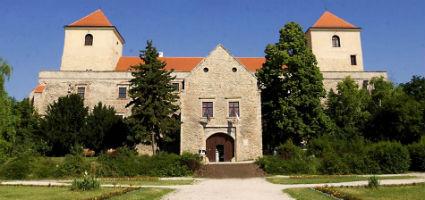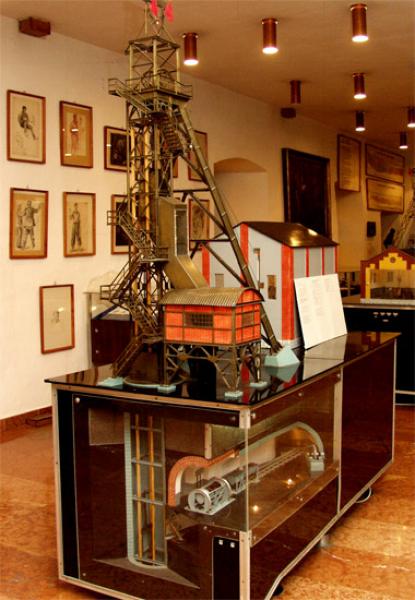2024. November 21. Thursday
Central Mining Museum - Várpalota Mining History Collection - Várpalota
 |
Address: 8100, Várpalota Hunyadi Mátyás tér 1.
Phone number: (88) 597-720
E-mail: titkarsag@szindbadkht.hu
Opening hours: 01.04-31.10.: Tue-Sun 11-17
|
Museum tickets, service costs:
|
Ticket for adults
|
600 HUF
|
|
|
Ticket for students
|
300 HUF
|
|
|
Ticket for pensioners
|
300 HUF
|
|
|
Ticket for families
|
1000 HUF
|
/ family
|
|
Group guide
|
4000 HUF
|
The exhibition takes place in 4 rooms of the Thury Castle and embraces the history of coal-mining in Várpalota, which started in 1876.In the first room there is a marble table with the date and reason of the foundation and also appreciation of those who contributed to the successes of 100 years. On the wall two painting shows the panorama of Várpalota in 1905 and in 1976. Also on show here the wooden statue of two miners made by Senior István Szabó, who has Kossuth Award. The memorial tablet in front of the entrance lists the name of those miners who died during work at Coal Mines of Várpalota Company.

In the first cabinet of the second room are deeds of gift, documents and copies of maps calling up the past. In the cabinets along the wall are the rocks of Várpalota's coal-basin, reliquiaes from the stratums of the basin of Várpalota, mineral coal-formations of Hungarian coal-basins, some notworthy pyrogenous, precipitated, metamorphic rocks, the most common minerals and ores, and the equipments of lining and land-surveying.
In the middle of the room are the models of surface and underground buildings from different periods. The most valuable of these are the Ferenc - I shaft (used 1934-1986) and a Skip shaft (It was used in Hungary in the S-I. vertical shaft, 1938-1984; it was the first transportation method that used bowk). On the walls are works of fine arts, and in the sight-hole of the 5m thick castle-wall are tools of mining. In the third room the development of mining securing apparatus is shown through three models. The first model is a wall-down wood-secured wide-work and the sections of its tunnels, the second model is wall-down secured by beam-post and steel bonnet wide-work and its tunnels, the third one is a working model of a shield-secured wide-work.
The selection of other shield-equipments and controlling-techonolgy devices are presented on charts and the electricity-operated models. In this room are the remembrances of the Miners Chorus, founded in 1920. In the cabinets are the personal equipments of the miners and safety devices. In front of the western window are the mining-theme paintings of artist from Várpalota, who donated these work of arts to the local government of Várpalota.
In the fourth room are the remembrances of Lajos Korompai who was the director of Várpalota Mine between of 1923 and 1939. Due to his work such events and developments, technical and technological changes occurred that helped the mine to become a modern factory. His cultural and social activity was significant. In 1935 with his guidance was the education of pitmen organized. In this room are the reminiscenses of sport-life of miners, and the charts showing the successes reached in sport and in culture.

In the first cabinet of the second room are deeds of gift, documents and copies of maps calling up the past. In the cabinets along the wall are the rocks of Várpalota's coal-basin, reliquiaes from the stratums of the basin of Várpalota, mineral coal-formations of Hungarian coal-basins, some notworthy pyrogenous, precipitated, metamorphic rocks, the most common minerals and ores, and the equipments of lining and land-surveying.
In the middle of the room are the models of surface and underground buildings from different periods. The most valuable of these are the Ferenc - I shaft (used 1934-1986) and a Skip shaft (It was used in Hungary in the S-I. vertical shaft, 1938-1984; it was the first transportation method that used bowk). On the walls are works of fine arts, and in the sight-hole of the 5m thick castle-wall are tools of mining. In the third room the development of mining securing apparatus is shown through three models. The first model is a wall-down wood-secured wide-work and the sections of its tunnels, the second model is wall-down secured by beam-post and steel bonnet wide-work and its tunnels, the third one is a working model of a shield-secured wide-work.
The selection of other shield-equipments and controlling-techonolgy devices are presented on charts and the electricity-operated models. In this room are the remembrances of the Miners Chorus, founded in 1920. In the cabinets are the personal equipments of the miners and safety devices. In front of the western window are the mining-theme paintings of artist from Várpalota, who donated these work of arts to the local government of Várpalota.
In the fourth room are the remembrances of Lajos Korompai who was the director of Várpalota Mine between of 1923 and 1939. Due to his work such events and developments, technical and technological changes occurred that helped the mine to become a modern factory. His cultural and social activity was significant. In 1935 with his guidance was the education of pitmen organized. In this room are the reminiscenses of sport-life of miners, and the charts showing the successes reached in sport and in culture.
